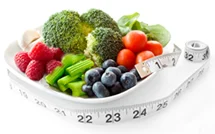How To Lose Weight Without Counting Calories
Are some calories more fattening than others? No. But some foods are more fattening than others because each bite is jam-packed with calories. You can dramatically cut calories, feel full, and enjoy a lot of good food as long as you focus on low-calorie-dense foods. Here are 6 top tips.
Are some calories more fattening than others? No. But some foods are more fattening than others because they are jam-packed with calories. Each bite packs a huge calorie punch.
For about 250 calories, you can have one small bag of French fries, or you can have four ears of corn on the cob. It’s pretty easy to see which food is going to tame your hunger more. After eating that bag of fries, there’s a pretty good chance you’re thinking, “I’d like another bag of fries, and maybe a cheeseburger.” About 1,000 calories later, you’re full.
Now, will four ears of corn keep you on the straight and narrow? Look at it this way: Because the corn does a much better job of quelling hunger than the small bag of fries, you’re going to be less tempted to head out an hour later for Domino’s. (Or maybe if you do end up at Domino’s, one slice of pizza is all you need, not three, four, and five.)

How to lose weight without counting calories
The point is: You can dramatically cut calories, feel full, and enjoy a lot of good food as long as you focus 90% or more of the time on lower-calorie-dense foods like vegetables, fruit, hot whole-grain cereals like oatmeal, beans (think hearty rich soups like black bean and minestrone), nonfat dairy and soy products, potatoes, whole-grain pastas, brown rice, sweet potatoes, corn, and lean animal proteins like fish, white poultry, and bison.
You don’t need to count calories, but every little calorie does count. Just 100 extra calories per day puts on 10 extra pounds per year. So every time you choose low-calorie-dense foods over high-calorie-dense ones (apples instead of apple chips, baked potatoes instead of fries, hot cereal instead of dry cereal) you’re doing your health and waistline a world of good. A cup of granola can easily tally up 500 belly-busting calories; a cup of cooked oatmeal topped with fresh fruit is 200 calories. Making this one simple switch at breakfast can help you drop about 30 pounds in one year.

Learn More About Pritikin
To feel full on fewer calories, here are 6 basic rules:
1. Eat foods with the lowest calorie density first. Save the most calorically dense foods for last.
Start dinner, for example, with a big veggie salad, and then, some vegetable soup. Vegetables are low in calories but filling because of their fiber and water content. Several studies have now documented that if you start out your meal with a low-calorie-dense vegetable salad or soup, you will eat fewer total calories for that meal.
When going out to eat, ask that the bread basket NEVER TOUCH your table. Request instead a fresh veggie plate or salad, and that it be served FIRST THING – even before you get the menus. (Tell the server your health demands it; that usually gets them moving quickly to the kitchen.)
Especially dangerous is bread accompanied with those little saucers of olive oil – a popular appetizer freebie at many Mediterranean-style restaurants. Eating bread dipped in oil is the caloric equivalent, bite for bite, of eating German chocolate cake.
2. Dilute calorically dense foods with calorically light ones.
If you decide you’re going to eat a calorie-dense food, say, baked tortilla chips, think about what you can have with it to lower (dilute) the total calorie density of the foods you’re eating. How about some bean dip and salsa? By scooping up each chip with beans and salsa, you’ll very likely eat fewer of the high-calorie-dense chips.
Here’s another example: If you’re having dried cereal (which adds up to a whopping 1,700 calories per pound), pour a little less cereal in your bowl, but top it with lots of fruit (just 300 calories per pound). The result? A lower total calorie density. The fruit fills you up and keeps you from eating too much of the calorically concentrated cereal.
3. Cheat smart.
If you want a little fat, say, almonds or guacamole, pair it with foods, like salads and other vegetables, that are very low in caloric density. It’ll have much less impact on the total caloric count of the foods you’re eating than if you added that same amount of fat to foods high in caloric density, like breads and chips.
4. Know your priorities. Your best food choices are high in water, low in fat, and high in fiber.
Eat your water! Water-rich foods are filling but not fattening. Fresh fruit (very rich in water) averages only 300 calories per pound, while dried fruit (very little water) adds up to a waist expanding 1,300 calories per pound. Pasta, full of water, has 500 calories per pound; bread, 1,250 calories per pound. Oatmeal has 300 calories per pound; dry cereal, 1,700 calories per pound. Quite often, water-rich foods are also rich in fiber and low in fat.
Remember, though, that a “fat free” food is not necessarily a low-in-caloric-density food. Fat-free cookies often pack in more than 1,500 calories per pound; fat-free bagel chips, close to 2,000 calories per pound. With carbs like these, it wouldn’t take long to go overboard on calorie consumption.
5. Don’t eat when you’re not hungry.
Researchers have found that if you eat a snack when you’re not hungry, that snack provides little satiety, or sense of fullness, compared to eating the same snack when hungry.
6. Limit calorie-rich beverages. (In other words, don’t drink your calories.)
Several studies have demonstrated that calories from liquids do not curb your appetite as well as the same number of calories from solid foods. Put simply, choose fruit over fruit juices. Or flavor your iced tea with lemon and/or Splenda instead of sugar or honey.
And be on the lookout for smoothies. People think they’re healthy, and their names often sound healthy, like the Fruit Blast Smoothies at Baskin-Robbins, but each smoothie at Baskin-Robbins ranges from 400 to 850 calories. Ouch!
Bottom Line: If you’re watching your weight, it’s always better to eat, rather than drink, your calories. Even so-called “light” drinks can be calorie-dense. A grande Frappuccino Light at Starbucks is 140 calories (plus, you know your drink isn’t going to be enough, so you’re aching for one of those 500-calorie muffins in the glass counter.) For the equivalent amount of calories – 140 – you can have a big navel orange and a bunch of green grapes and a bag of baby carrots. A lot of filling healthy food – and no more muffin cravings!
